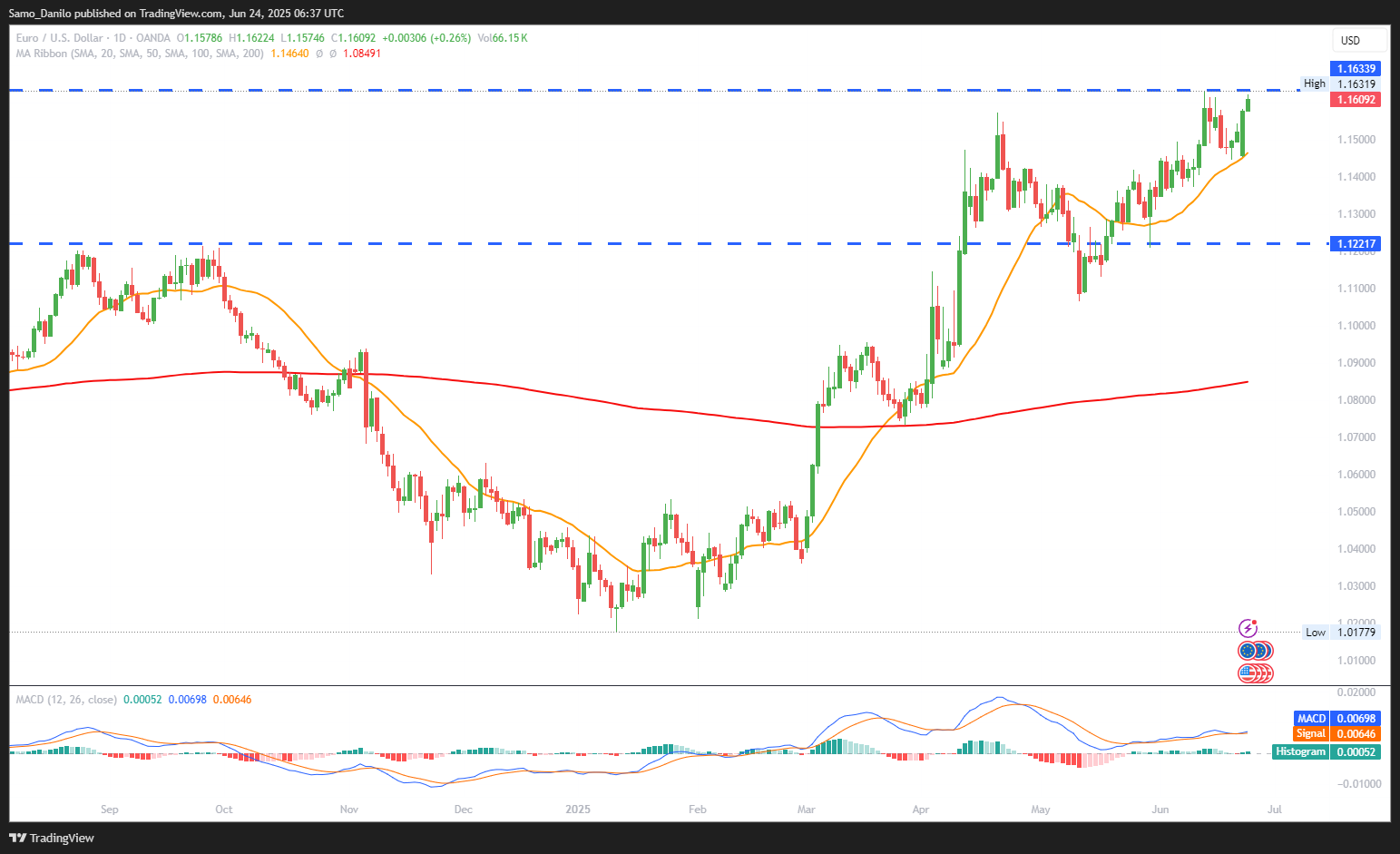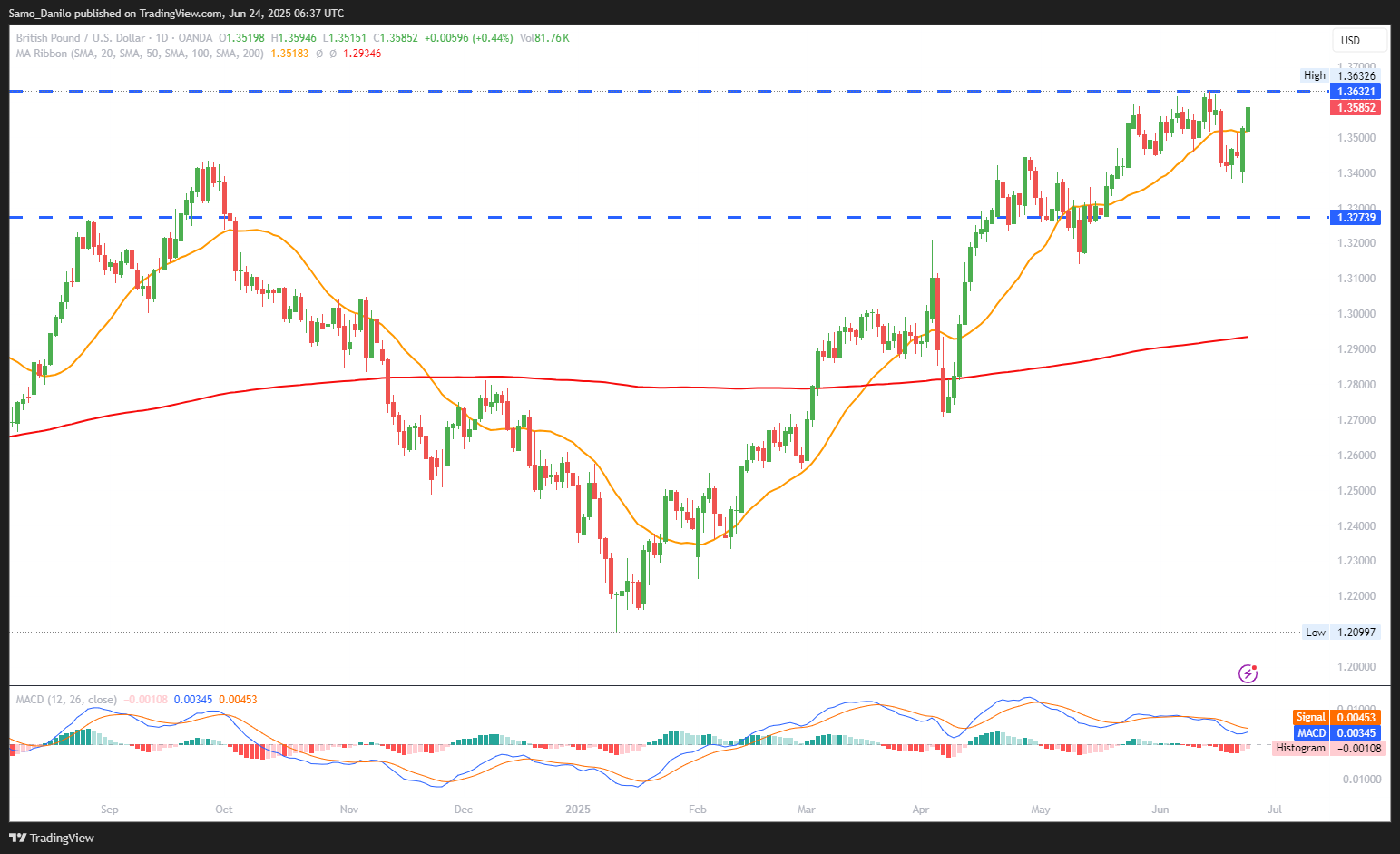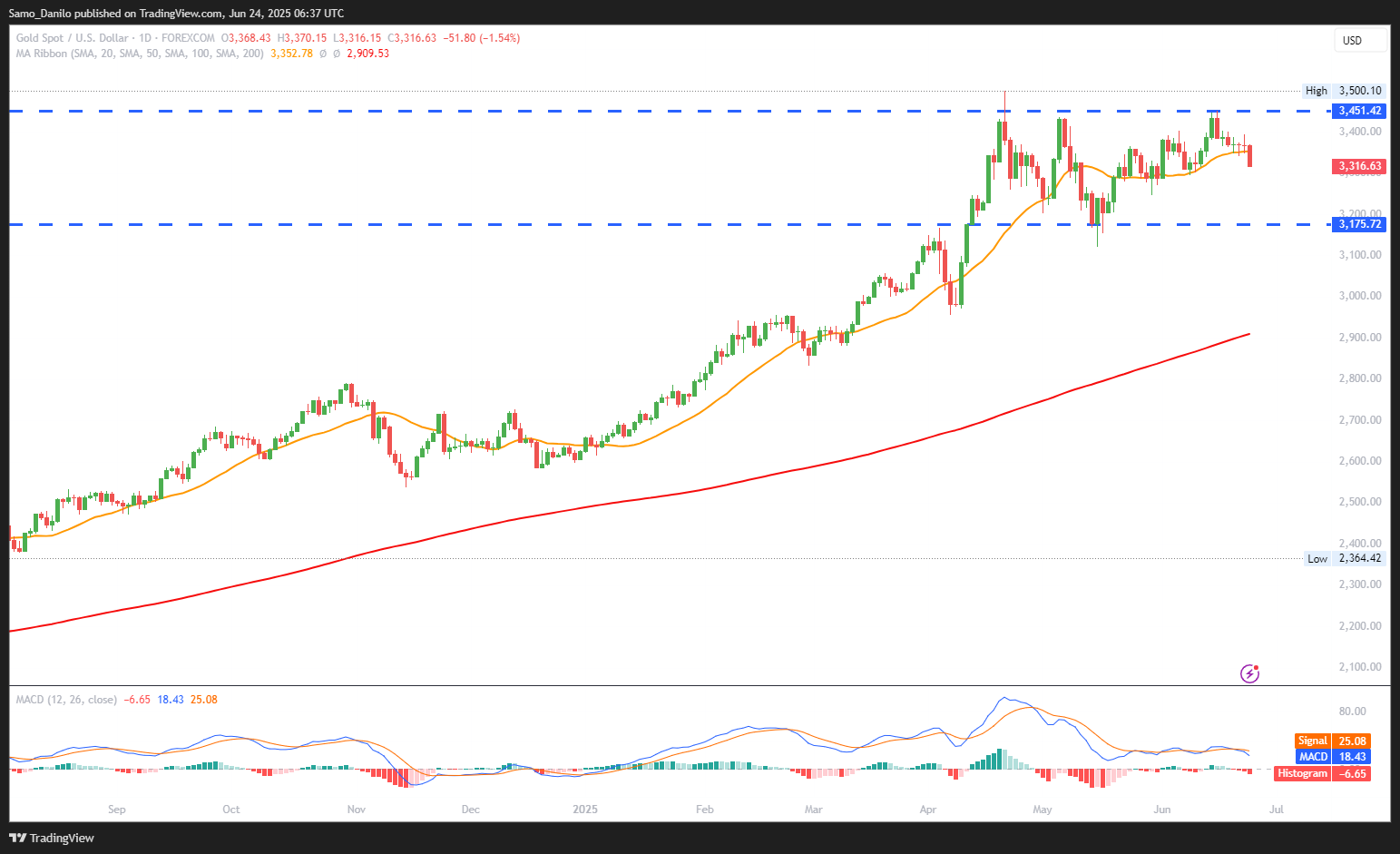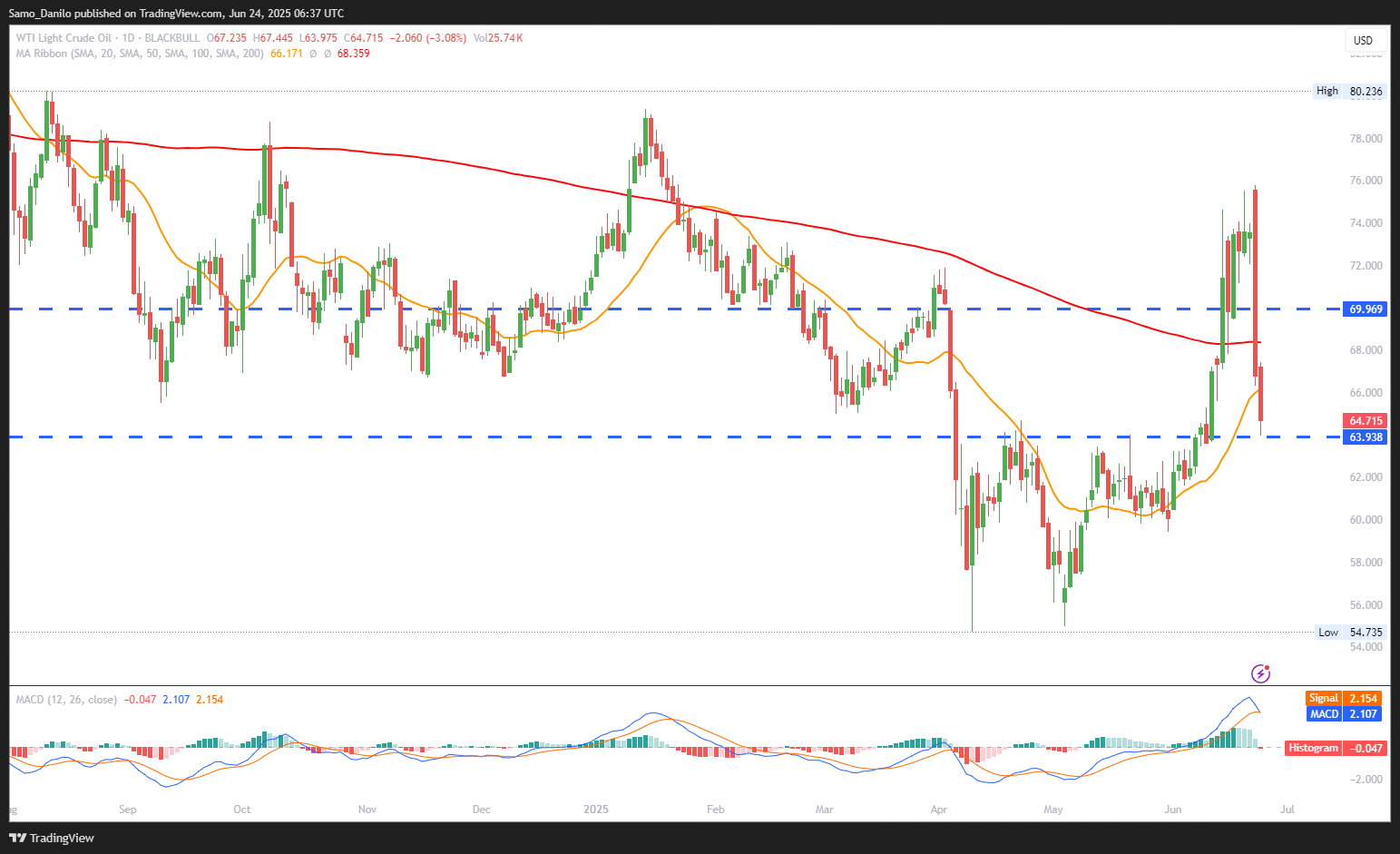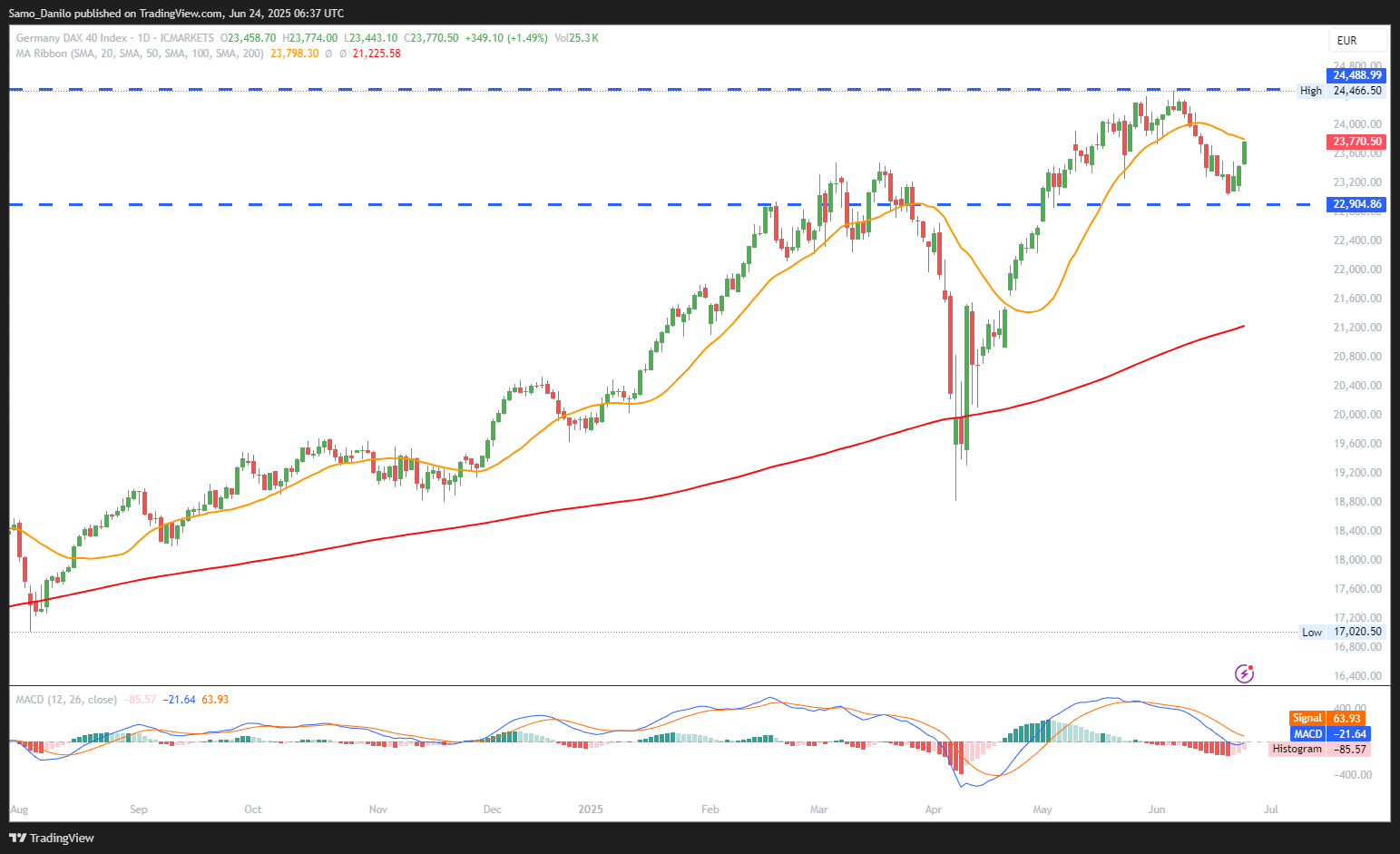EURUSD
- EUR/USD Price: The EUR/USD pair climbed to a new weekly high of 1.1610 during late European trading on Tuesday, driven by shifting interest rate expectations and cautious sentiment around U.S. and Eurozone economic outlooks.
- Fed's Bowman: Fed Governor Michelle Bowman indicated she is open to a rate cut as early as July, citing mounting concerns about U.S. labor market conditions
- Fed Rate Cut: According to the CME FedWatch tool, the probability for the Fed to reduce interest rates next month has increased to 22.7% from 14.5% recorded on Friday.
- US Tariff Policy: The ECB is growing increasingly concerned about the potential economic impact of President Trump’s new tariff measures, which could weigh heavily on the already fragile Eurozone recovery and consumer sentiment.
- ECB's Lagarde: On Monday, Christine Lagarde said in her prepared remarks before the European parliament economic committee that survey data point to “some weaker prospects for economic activity in the near term”. "Risks to the growth outlook remain tilted to the downside," Lagarde added."
Closing statement: EUR/USD’s move higher reflects growing expectations for Fed easing and concerns about global trade tensions. Traders are now watching for confirmation of U.S. rate cut intentions and upcoming Eurozone PMI and inflation data for further direction.
GBPUSD
- GBP/USD Price: The GBP/USD pair advanced to around 1.3560 in early European trading on Tuesday, supported by a broad decline in the US Dollar and stronger UK macroeconomic data.
- UK PMI: Preliminary S&P Global PMI data for June showed stronger-than-expected growth in both UK manufacturing and services sectors. The Composite PMI rose, signaling broad-based expansion, which reinforced investor confidence in the UK economic recovery.
- Fed's Waller: Fed Governor Christopher Waller suggested the US central bank could consider cutting rates as early as July, adding to market expectations of a more accommodative Fed stance and putting pressure on the USD.
- US PMI Data: US PMI figures released Monday showed stable manufacturing activity but slightly weaker service sector performance, with the Composite PMI slipping to 52.8 from 53.0 in May. The mixed data kept the dollar subdued and aided GBP/USD’s gains.
- Central Bank Speeches: Investors are awaiting speeches from BoE Governor Andrew Bailey and Fed Chair Jerome Powell later Tuesday, which could shape the near-term monetary policy outlook and impact currency volatility.
Closing statement: GBP/USD’s gains reflect UK economic resilience and waning USD strength, as rate cut speculation rises in the US. Traders now turn to central bank commentary for signals on future policy direction and sustained trend momentum.
XAUUSD
- XAU/USD Price: Gold remains on the back foot for a third straight day, trading below key short-term resistance, as bearish momentum continues. Despite this, the metal has held above the 50-day SMA at $3,324, a critical support zone.
- Technical Outlook: The daily chart shows Gold struggling at the 21-day SMA around $3,352, with only a modest recovery from recent lows near $3,333. The inability to reclaim the 21-day SMA suggests fragile bullish momentum.
- Ceasefire: Gold’s traditional safe-haven appeal weakened after US President Trump and Iranian FM Araghchi jointly announced a ceasefire, calming geopolitical tensions and leading to reduced investor demand for gold.
- Tariff Strategy: Markets remain uncertain about the White House’s tariff direction, as the July reciprocal tariff deadline approaches. Trade policy uncertainty persists, but has so far taken a back seat to geopolitical developments.
- Powell’s Testimony: Traders are now eyeing Fed Chair Jerome Powell’s two-day congressional testimony starting Tuesday, which could offer new signals on the timing and scale of upcoming interest rate cuts, influencing gold’s path forward.
Closing statement: Gold is technically vulnerable but finding support near key moving averages, with fading geopolitical risk and Fed policy expectations in focus. Powell’s testimony will be pivotal in determining whether the yellow metal can regain upward momentum.
CRUDE OIL
- Crude Oil Price: West Texas Intermediate (WTI) crude prices declined for a second consecutive session, falling over 1.30% on Tuesday to trade just above $66.00. The drop followed a sharp retracement from last week’s five-month peak of $76.75, signaling a cooling of bullish momentum.
- Geopolitical Tensions: Oil markets reacted positively after Iran’s retaliatory strike targeted a US base in Qatar rather than disrupting oil shipping lanes, particularly the Strait of Hormuz.
- Ceasefire: Adding to this, US President Donald Trump announced a complete ceasefire between Israel and Iran. This helps ease market worries about supply disruptions from the Middle East, a major oil-producing region.
- NATO Summit: At the NATO summit (June 24–25), leaders are expected to agree on a 5% defense spending target, potentially reshaping long-term global fiscal priorities. While not immediately market-moving, this context highlights the geopolitical backdrop against which energy markets are trading.
- Upcoming Data: Traders now look forward to the US economic docket, featuring the release of the Conference Board's Consumer Confidence Index and the Richmond Manufacturing Index.
Closing statement: Crude oil is under pressure as geopolitical risk premiums fade, prompting a correction from recent highs. With attention shifting to macroeconomic indicators, traders will watch demand-side data for cues on whether WTI can stabilize or face further downside.
DAX
- DAX Price: The DAX surged nearly 1.5% in morning trading to around 23,750, breaking decisively above its recent consolidation zone of 23,000–23,500. The breakout reflects renewed risk appetite and technical momentum as the index eyes a move toward previous highs.
- Eurozone PMI: Euro area PMIs for June were slightly below expectations, with the composite holding steady at 50.2 (vs. 50.5 expected). Services PMI met consensus at 50.0, while manufacturing remained weak at 49.4, suggesting economic stagnation across the bloc.
- German Economy: In contrast, Germany’s PMI composite jumped to 50.4 in June from 48.5 in May, pointing to early signs of recovery. Focus now shifts to June’s Ifo Business Climate indicator, which could confirm the improving domestic sentiment.
- Merz Talk: Chancellor Merz criticized the EU's complex approach to US trade talks, calling for streamlined agreements in key sectors like autos and chemicals. The remarks highlight growing pressure to deliver trade clarity amid shifting geopolitical alliances.
- Rate Cuts: White House NEC Director Kevin Hassett reiterated there is "no reason" for the Fed not to cut rates, reinforcing the dovish narrative. Market participants are also monitoring continuous US-China trade coordination, with Treasury Secretary Bessent and USTR Greer in frequent contact with Beijing.
Closing statement: The DAX’s breakout above consolidation range is fueled by technical strength and improving domestic indicators, even as Eurozone-wide data remain tepid. Central bank signals and global trade talks will likely drive the next directional move.
